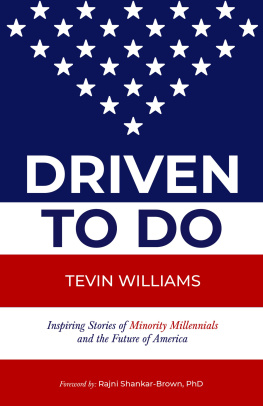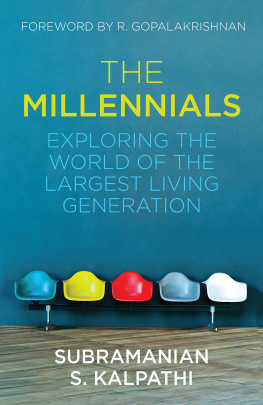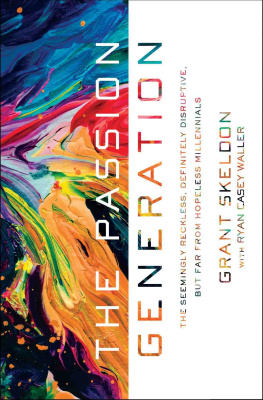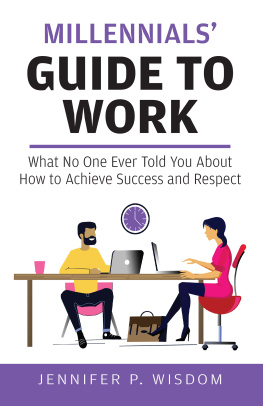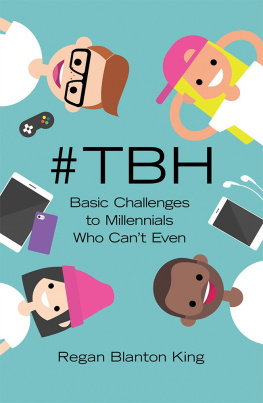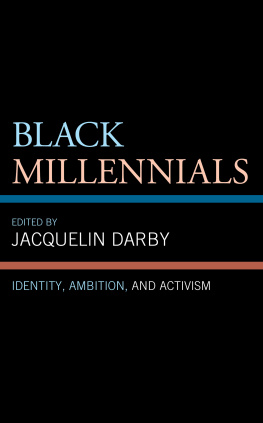FOREWORD
WRITTEN BY: RAJNI SHANKAR BROWN , PH.D.
We are living in precarious and turbulent times. With widening social inequalities and escalating environmental degradation, our world is overflowing in deep distress. As a mother, educator-scholar, activist, and artist, the expansive spectrum of daunting issues which often keep me awake at night also motivate and fuel my lifes work. These issues are heavy and draining. Thankfully, in the midst of feeling incredible angst, I still find immeasurable hope and peace while teaching, learning, and growing alongside my students. Although I work at a Predominantly White Institution (PWI) in Central Florida and often experience the painful realities of intersectional -isms, I am fortunate to be a part of diverse circles that form beloved communities. While these circles remain small due to where I am situateda PWI in a small town located in the Deep Souththey are nonetheless massive in heart and soul. Among those in my beloved community is Tevin Williams.
After over a decade in the UNC system, in 2013 I embarked on a new adventure and joined the Department of Education in the College of Arts and Sciences at Stetson University. As a faculty member, I have the privilege of working with both undergraduate and graduate students. Furthermore, as a publicly engaged scholar, I work closely in and with diverse communities; in fact, all of my courses are grounded in community engagement, equity, and social justice. I had the joy of meeting Tevin not long after joining Stetsons faculty. While he was not a student in my classeshe was working in student affairs and pursuing his MBA in the Stetson University School of BusinessTevin often participated in various workshops and programs I facilitated on campus, outside of class time. The majority of educational events I organize focus on human and civil rights, cultural diversity and inclusion, equity and eco-justice, art and activism, and contemplative practicesareas which were integrally intertwined with Tevins interests and callings. Additionally, whenever Tevin and I saw each other organically, around campus or in town, we would pause and engage in conversation. Our exchanges were remarkably honest and raw, full of contemplative dialogue, and often interdisciplinary in nature. We would share our own hardships and heartache, especially from our shared but distinct experiences of living in the Deep South, and working at a PWI. We would discuss social-political events in global and local contexts and would frequently plot pathways for building healthier, inclusive communitieswhile affirming our shared commitment for working towards a better, more just tomorrow. Our exchanges were always meaningful and inspiring, even when they were brief and in passing.
Teaching and working alongside individuals like Tevin fills my heart with immeasurable hope and peace, and further fuels my motivation to keep marching for equity and justice. From the first time I met Tevin, he was so clearly driven to do in a world inundated with growing disparities and suffering. Knowing millennials like Tevinmillennials focused and diligently working to impact our worldis uplifting. The complex challenges of todays world require we advocate with intention and work to transform current narratives of injustice. We must collectively invest our time, energy, skills, and resources toward dismantling white supremacy, which pervades and continues to fuel colonialism and substantial inequalities. If we are to advance justice, we must actively address deeply-entrenched systems of oppression marginalizing people of color in the United States and resulting in recurrent brutalities. As Shanelle Matthews, director of communications for Black Lives Matter Global Network, explains, Its important to remember that white supremacy is not just people in hoods....White supremacy is a web of violent and abusive behaviors bolstered by white nationalists, racist elected officials, violent police and law enforcement, corporate money....[and] if we want to win this battle, we need to open our eyes to all the symbiotic ways white supremacy touches each and every one of our livesand then come up with the best course of action to fight it.
Just as my Amma, my mom, taught me, I teach my students about the power of human stories. I engage my students in lessons which emphasize the critical importance of recognizing whose stories are being told and whose are notreflecting on the why that oxygenates these biased historical to present-day rootsand the imperative of collectively being driven to do in advocating and carving out space for new stories affirming diversity. I believe a vital part of challenging white supremacy is elevating and amplifying diverse voices and stories. Sharing a sundry of stories which reflect the beautiful mosaics that create our diverse communities help in building bridges to heal and educate; simultaneously, they tackle gross disparities between the values of colonialism and those of historically-socially oppressed, underrepresented, and underserved populations.
We must provide our children a wide array of positive role models and ensure they have opportunities to build colorful palettes as they aspire and grow; Tevin accomplishes this by writing Driven to Do. He focuses on minority millennials working to create a future worth fighting for and collectively shaping a better tomorrow. I am heartened by these diverse millennials, who I view as luminous solutionaries in these exceptionally turbulent times. While the millennial generation in the United States is often labelled in a negative light, my experiences recurrently reveal they are innovative and passionately driven to forge a better tomorrow for all of us.
According to the Pew Research Center, Millennials are the most racially diverse generation in American history. They are an incredibly resourceful generation, as visible in their successful building of networks through social media. They are notably optimistic, care deeply about social problems, and are committed to creating the change they want to see in our world. Through their political and civic engagement efforts, numerous millennials are mindfully engaged in efforts focused on addressing social inequalities. In The Civic and Political Participation of Millennials, fellows Hollie Russon Gilman and Elizabeth Stokes write, Millennials have come of age in a time of shifting landscapes and tumultuous change. Growing up in the Information Age, Millennials are empowered by information and demand transparency and authenticity....And as a cohort, Millennials have already confronted several major crisesfrom domestic terrorism to the Great Recession to climate change. Millennials unique historic experiences have shaped their relationship with politics and their communities (2014, p. 57). Numerous millennials whom I have the fortune of knowing and teaching are actively organizing, mobilizing, agitating, and persisting.

